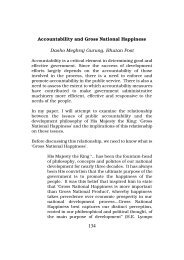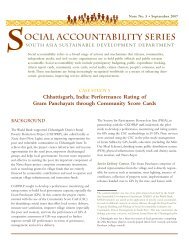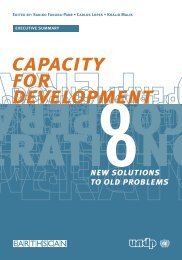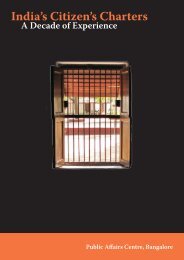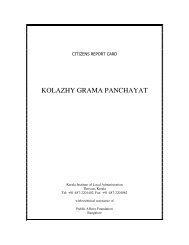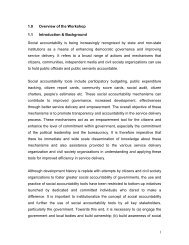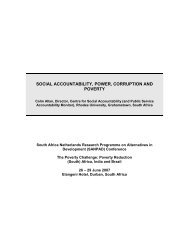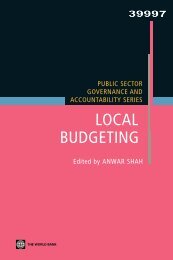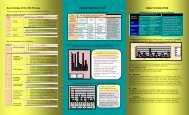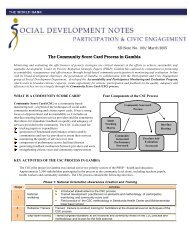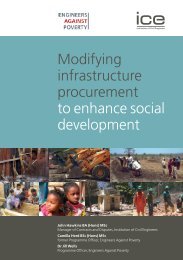Enabling Environment for Social Accountability in ... - SASANet
Enabling Environment for Social Accountability in ... - SASANet
Enabling Environment for Social Accountability in ... - SASANet
You also want an ePaper? Increase the reach of your titles
YUMPU automatically turns print PDFs into web optimized ePapers that Google loves.
Annex 1. <strong>Social</strong> <strong>Accountability</strong> and Legal Advocacy:<br />
The National Center Aga<strong>in</strong>st Violence 53<br />
BRINGING A SOCIAL PROBLEM OUT OF THE SHADOWS<br />
The National Center Aga<strong>in</strong>st Violence was <strong>in</strong>itially founded <strong>in</strong> 1995 by three Mongolian women’s<br />
organizations: the Liberal Women’s Bra<strong>in</strong> Pool, Women <strong>for</strong> <strong>Social</strong> Progress, and the Women Lawyers’<br />
Association (WLA). At that time it was known as the Center Aga<strong>in</strong>st Violence (CAV). After CAV<br />
became an autonomous organization, it reregistered with the M<strong>in</strong>istry of Justice and Home Affairs as the<br />
National Center Aga<strong>in</strong>st Violence <strong>in</strong> January 1998. Dur<strong>in</strong>g this early period, domestic violence (DV) was<br />
a concept that was unknown <strong>in</strong> Mongolian society; there was little <strong>in</strong><strong>for</strong>mation about or discussion of the<br />
widespread abuse of Mongolian women and children. The found<strong>in</strong>g of the Center was an important step<br />
to br<strong>in</strong>g DV out of the shadows so that both its symptoms and causes could be legally and socially<br />
addressed.<br />
The NCAV’s <strong>in</strong>itial mission was twofold: to provide legal and psychological counsel<strong>in</strong>g and shelter to<br />
victims, and to educate the government and the public on domestic violence. As a result of an <strong>in</strong>ternal<br />
reassessment <strong>in</strong> 2002, the NCAV realized that its fight aga<strong>in</strong>st DV must <strong>in</strong>clude the trans<strong>for</strong>mation of<br />
social structures. To achieve its mission, the NCAV attempts to: 1) raise public awareness and shape the<br />
social m<strong>in</strong>dset so that DV is no longer tolerated; 2) build a legal framework that effectively prevents and<br />
ultimately elim<strong>in</strong>ates violence; and 3) develop a social protection system that overcomes the<br />
consequences of violence (NCAV 2005). Whereas the motto of the organization is “a human life free<br />
from violence,” the central message <strong>in</strong> both their public awareness campaign and legal advocacy has been<br />
that “DV is not just a private issue,” thus requir<strong>in</strong>g the <strong>in</strong>tervention of both Mongolian civil society and<br />
the government.<br />
The NCAV is governed by a seven-member board, which <strong>in</strong>cludes representatives from the M<strong>in</strong>istry of<br />
<strong>Social</strong> Welfare and Labor (MSWL), the Parliamentary Secretariat, the Ulaanbaatar Citizen<br />
Representatives’ Khural, the UB Police Department, and associations of women, children, and the elderly.<br />
Representatives of elderly Mongolians are <strong>in</strong>cluded on the NCAV board as one <strong>in</strong> four Mongolians over<br />
the age of 50 is a victim of DV. This statistic is nearly as high as the number <strong>for</strong> Mongolian women (one<br />
<strong>in</strong> three) who suffer from DV (NCAV et al. 2003; NCAV and TAF 2003). 54<br />
More than 20 donors, mostly <strong>in</strong>ternational, <strong>in</strong>clud<strong>in</strong>g the embassies and aid agencies of the United States,<br />
the United K<strong>in</strong>gdom, the European Union, Germany, Sweden, and Australia, have provided f<strong>in</strong>ancial<br />
assistance to NCAV <strong>in</strong> its ef<strong>for</strong>ts aga<strong>in</strong>st DV. Four Mongolian donors, both governmental and<br />
nongovernmental, have also contributed to the NCAV: the MSWL, the Poverty Alleviation Program<br />
Office, the Mongolian Women’s Fund, and the National AIDS Foundation. Significant and diverse<br />
<strong>in</strong>ternational fund<strong>in</strong>g has allowed the NCAV to pursue legal advocacy and provide services to victims<br />
that the GoM has not been able to provide (F<strong>in</strong>d<strong>in</strong>g NCAV-1).<br />
53 Research <strong>for</strong> this case study was conducted primarily by Oyuna Baasanjav, Gender and Participation Specialist,<br />
World Bank-Mongolia.<br />
54 In 1995, a survey <strong>in</strong>volv<strong>in</strong>g 5,000 respondents was jo<strong>in</strong>tly conducted by the NCAV and the M<strong>in</strong>istry of<br />
Population Policy and Labor. In 1998, another survey <strong>in</strong>volv<strong>in</strong>g 3,000 respondents was jo<strong>in</strong>tly conducted by the<br />
NCAV and the Center <strong>for</strong> Tra<strong>in</strong><strong>in</strong>g and Research <strong>for</strong> the Population at the National University of Mongolia. In 2003,<br />
a survey of 1,000 elderly Mongolians was jo<strong>in</strong>tly conducted by the NCAV and the Federation of Senior Citizens<br />
(NCAV and TAF 2003).




